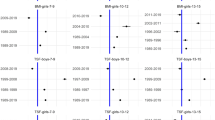Abstract
This report gives results of a longitudinal study of two cohorts of school children in Norway and West-Germany. The rate of growth in body size and composition is identical for the two samples, but different for the two sexes, and follows closely the trend of growth which has been found for North-Europeans in general.
Despite of this similarity in growth of anatomical variables the Norwegian children appeared to be superior in their maximum aerobic power at all comparable ages and in both sexes. The differences between means in maximal oxygen uptake varies somewhat with age and sex and are in the range of 5–10%.
It is suggested that the mean differences between Norwegian and German children in their exercise and cardio-vascular fitness are brought about by a more physically active behavioural pattern of living in Norway.
Similar content being viewed by others
References
Andersen KL, Shephard RJ, Denolin H, Varnauskas E, Masironi R (1971) Fundamentals of exercise testing. World Health Organization, Geneva
Andersen KL, Seliger V, Rutenfranz J, Mocellin R (1974) Physical performance capacity of children in Norway. Europ J Appl Physiol 33:177–195
Andersen KL, Masironi R, Rutenfranz J, Seliger V (1978) Habitual physical activity and health. WHO Regional Publications, European Series No. 6. World Health Organization, Regional Office for Europe, Copenhagen
Åstrand P-O, Engström L, Eriksson BO, Karlberg P, Nylander I, Saltin B, Thorén C (1963) Girl swimmers. Acta Paediatrica, Suppl 147
Bailey DA, Ross WD, Mirwald RL, Weese C (1978) Size dissociation of maximal aerobic power during growth in boys. In: Borms J, Hebbelinck M (eds) Pediatric work physiology. Medicine Sport, Vol 11, pp 140–151 (Karger, Basel)
Ekblom B (1971) Physical training in normal boys in adolescence. Acta Paediat Scand (Stockh) Suppl 217:60–62
Eveleth PB, Tanner JM (1976) Worldwide variation in human growth. Cambridge University Press, Cambridge London New York Melbourne
Hermansen L, Oseid S (1971) Direct and indirect estimation of maximal oxygen uptake in pre-pubertal boys. Acta Paediat Scand (Stockh) Suppl 217:18–23
Kobayashi K, Kitamura K, Miura M, Sodeyama H, Murase Y, Miyashita M, Matsui H (1978) Aerobic power as related to body growth and training in Japanese boys: a longitudinal study. J Appl Physiol 44:666–672
Lenz W (1971) Wachstum und körperliche Entwicklung. In: Bierich JR, Grüttner R, Schäfer K-H (Hrsg) Geschichte der Kinderheilkunde. Physiologie und Pathologie der Entwicklung. Springer Verlag, Berlin Heidelberg New York, pp 33–107
Pařizková J (1977) Body fat and physical fitness. Martinus Nijhoff B.V. The Hague
Rehs HJ, Berndt I, Rutenfranz J, Burmeister W (1975) Untersuchungen zur Bestimmung der Hautfaltendicke mit verschiedenen Kalipern. Z Kinderheilk 120:121–133
Rehs HJ, Berndt I, Rutenfranz J (1978) Untersuchungen über den Einfluß verschiedener Rechenansätze auf die Ermittlung des relativen Fettanteils am Körpergewicht mit Hilfe von Hautfaltenmessungen. Klin Pädiat 190:267–279
Shephard RJ, Lavallée H, Jequier J-C, LaBarre R, Rajic M, Beaucage C (1978) Seasonal differences in aerobic power. In: Shephard RJ, Lavallée H (eds) Physical fitness assessment. Principles, practice and application. C.C. Thomas, Spring-field, Ill
Shephard RJ, Lavallée H, Jequier J-C, LaBarre R (1979) Physical education in the primary school — an experiment in French Canada. S.A.J. Research in Sport, Physical Education and Recreation 2:63–72
Tanner JM, Whitehouse RH (1955) The Harpenden skinfold caliper. Amer J Phys Anthrop N S 13:743–746
Thorén C, Seliger V, Maček M, Vávra J, Rutenfranz J (1973) The influence of training on physical fitness in healthy children and children with chronic diseases. In: Linneweh F (ed) Current aspects of perinatology and physiology of children. Springer Verlag, Berlin Heidelberg New York, pp 83–112
Weiner JS, Lourie JA (1969) Human biology: a guide to field methods. Blackwell Scientific, Oxford
World Health Organization (1977) Health needs of adolescents. Technical Report Series. 609, Geneva
Author information
Authors and Affiliations
Rights and permissions
About this article
Cite this article
Rutenfranz, J., Andersen, K.L., Seliger, V. et al. Maximum aerobic power and body composition during the puberty growth period: Similarities and differences between children of two European countries. Eur J Pediatr 136, 123–133 (1981). https://doi.org/10.1007/BF00441914
Received:
Issue Date:
DOI: https://doi.org/10.1007/BF00441914




